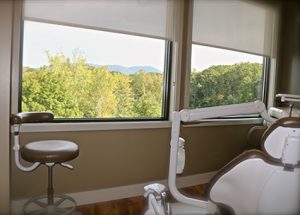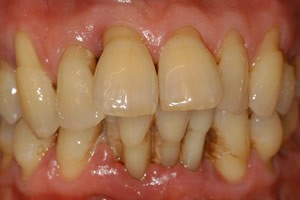Header logo
header top contact widget
oral bacteria
Obesity Increases Risk Of Gum Disease.
Posted on Nov 20, 2019 by William J. Claiborne, DDS MS
Imagine one-third of your body being made up of maple syrup.
Sounds pretty absurd, doesn’t it? Yet, for Americans who are categorically obese, this imagery is actually a good description.
Obesity is when fat makes up over thirty percent of body mass. According to the Centers For Disease Control & Prevention (CDC), adults in the U.S. who are categorized as obese is at nearly 40 percent! Another 30 percent are categorized at overweight. That’s two-thirds of adults in the U.S. who have too much fat makeup.
And it’s not just adults over the age of 20 who have this problem. Sadly, nearly 30 percent of children are overweight or obese as well.
In North Carolina, over 63 percent of adults are either overweight or obese, according to a study by the Reasons for Geographic and Racial Differences in Stroke (REGARDS) study. (https://onlinelibrary.wiley.com/doi/full/10.1002/oby.20451)
The problems associated with being overweight and obese are many, and can be deadly. Obesity seems to trigger a predisposition to a variety of serious health conditions and diseases. These include increased risk of stroke, certain cancers, coronary artery disease, and type 2 diabetes.
In addition to the added and unnecessary load that strains the back, knees and ankles, the challenges continue. Obesity decreases lifespan, up to an estimated 20 percent of people who are severely obese. (https://www.nejm.org/doi/full/10.1056/NEJMsr043743)
As 2019 holiday indulgences (often sugary and carb-laden) are before us, many of us also follow the season with with the traditional new year’s resolution of “lose weight” at the top of the list. Along with improved health and greater confidence in overall appearance, we’d like to add another reason to reach your goal.
Chronic inflammation is a known side effect obesity. Why does this matter to a Periodontist? Obesity is also known to exacerbate other inflammatory disorders, including periodontitis (advanced gum disease). To be clear, periodontal disease is also the nation’s leading cause of adult tooth loss.
Research has shown that obese adults have a 6 times higher potential to develop periodontal (gum) disease. As a periodontal specialist my goal is always to help patients achieve optimal oral health. Although discussing the risks of periodontal disease with obese patients can be a sensitive issue, this is without judgement of why they are overweight but rather how we can help them enjoy a healthier smile.
Most of us know – losing weight is not a process that is either easy or quick. Add to this that research has shown that factors such as sleep quality and what we eat (as much as how much we eat) can cause the brain to make the challenges of weight loss even greater.
For one, studies have shown that sugar can be addictive. Sugar consumption even activates the same regions in the brain that react to cocaine. For individuals who admit to having a “sweet tooth,” trying to stay within the recommended 6 teaspoons per day limit can be a battle when we are truly “addicted.” (https://www.brainmdhealth.com/blog/what-do-sugar-and-cocaine-have-in-common/)
Insufficient sleep also complicates the brain’s ability to regulate hunger hormones, known as ghrelin and leptin. Ghrelin stimulates the appetite while leptin sends signals of feeling full. When the body is sleep-deprived, the level of ghrelin rises while leptin levels decrease. This leads to an increase in hunger.
The National Sleep Foundation states that “people who don’t get enough sleep eat twice as much fat and more than 300 extra calories the next day, compared with those who sleep for eight hours.” (https://www.sleepfoundation.org/sleep-topics/the-connection-between-sleep-and-overeating)
As difficult as losing weight can be, it is important to be aware of risk factors that can make you more suspectible to gum disease. Initial symptoms include gums that are tender, swollen, and may bleed when brushing. This stage, known as gingivitis, is actually reversible with prompt, thorough oral hygiene.
As gum disease worsens, however, the inflammation of oral bacteria can lead to persistent bad breath, receded gums that expose sensitive tooth roots, and gums that darken in color. If untreated, pus pockets can eventually form and the base of some teeth and tooth loosening can require removal.
Armed with this information, we want to help all patients, with overweight or obese adults especially, to take added precautions to maintain good oral health, both at home and through regular dental check-ups.
Avoiding periodontal disease is particularly important since its infectious bacteria have been linked to serious health problems. These include heart disease, diabetes, arthritis, some cancers, preterm babies, impotency, and Alzheimer’s disease.
If you are experiencing symptoms of gum disease, however, it is vital to be seen by a periodontist as soon as possible to halt further progression. A periodontist is a dental specialist who has advanced training in treating all stages of gum disease as well as in the placement of dental implants. The earlier the treatment, the less involved treatment requirements will be. Gum disease will not improve without professional care.
Call 828-274-9440 to schedule an initial examination or begin with a consultation.
Is Your Denture Increasing Your Risk For The Flu?
Posted on Nov 14, 2019 by William J. Claiborne, DDS MS
“Did you get your flu shot yet?”
Like every year, flu season is here. And part of the prevention measures many people take to avoid it are having their annual flu shot. Hopefully, this quick injection will help individuals to build up a resistance to getting it.
Even with this shot, however, a certain amount of people still get the flu. And, for people who have compromised immune systems, the flu can be a difficult illness to overcome. For some, it can lead to hospitalization and even death.
According to Harvard Health Publishing (https://www.health.harvard.edu/diseases-and-conditions/10-flu-myths): “in the United States alone, 36,000 people die and more than 200,000 are hospitalized each year because of the flu”.
Although we take precautions, such as washing hands and covering our mouths when we sneeze, germs are everywhere – especially in colder months when air circulates in more closed-in spaces.
When it comes to germs, an often overlooked source of germs are dentures and partials. Dentures, because of their gum-colored bases are porous, can be coated with a sticky bacteria known as biofilm. It has been found that this biofilm can harbor MRSA or bacteria that is resistant to antibiotics.
One study, published in the Journal of The American Dental Association, was conducted to determine methods to effectively kill bacteria in the material that make up the gum base of dentures and partials. The results, reported on by NBC News in 2012, revealed how truly serious these bacteria levels were. (https://www.nbcnews.com/healthmain/dirty-dentures-dangerous-mrsa-may-be-lurking-dentists-say-662637)
According to the report, dentures are “covered with thin layers of icky, sticky bacteria known as biofilms. Worse, some of the biofilm germs may be bad bugs such as MRSA, or drug-resistant staphylococcus aureus bacteria, which can lurk on the dentures until they’re breathed into the lungs, where experts fear they may cause nasty, hard-to-treat infections.”
The problems and risks don’t stop there. When bacteria in the mouth are breathed into the lungs, infections become much more difficult to treat. This is especially concerning due to the high number of denture and partial wearers who sleep in their appliances.
One study found that wearing dentures while sleeping doubles the risk of pneumonia in elderly adults. (https://www.ncbi.nlm.nih.gov/pmc/articles/PMC4541085/) While sleeping in dentures obviously increases health risks, these icky organisms can create quite an obstacle to adults who have immune systems that are already compromised.
Just because we don’t see the actions of organisms that are housed inside our bodies, we must not forget that bacteria are there – living, eating and waste-producing. The tiny hide-outs of denture ‘pores’ give oral bacteria an ideal environment to thrive and reproduce.
With the additional frustrations of wearing dentures and partials, it’s no surprise that dental implants have become the preferred choice of today’s adult when it comes to replacing natural teeth.
Dental implants are held by the jaw bone, restoring a sturdy foundation for biting and chewing. They also recreate stimulation to the bone that supports them, thus halting the rate of bone loss that occurs from wearing dentures. And, dental implants are designed to last a lifetime, making them an excellent investment.
As a Periodontist, my specialty includes advanced training in the diagnosis and placement of dental implants. Over the years, I have been impressed with their track record, having one of the highest of all implant-in-bone success rates.
Why worry over the health risks associated with wearing dentures and partials? Dental implants are dependable, safe, lasting, and provide a natural look and feel. Call 828-274-9440 to schedule an appointment to determine if dental implants are right for you.
Afraid of the Dentist? Here’s How To Get Your Smile Back!
Posted on Oct 11, 2019 by William J. Claiborne, DDS MS
Have you ever suddenly seen a snake out of the corner of your eye?
Immediately, the brain kicks in a “fight or flight” response that causes us to react. Because we don’t know whether or not the snake is poisonous, the typical reaction is to quickly move away from danger.
Past trauma can also trigger reactions. Past experiences can sometimes cause people to react in ways they can’t control. For adults who have experienced a frightening or painful dental procedure, the fear it caused can become embedded (sometimes forever) in the subconscious.
Some things that cause us to flinch or freeze can occur from reasons we can’t even explain. Patients who are nervous or afraid when they first arrive often know what past episode triggered it. Some are unable to recall an unpleasant dental visit yet react to certain sights, smells or sounds.
Dental fear occurs in different people at different levels. It can activate reactions of more rapid heartbeat, sweating, heavier breathing, and muscle tension.
Here, at our Asheville periodontal office, most patients are relaxed from the moment they walk in and throughout treatment. Some are fine until they are seated in the treatment chair while others are nervous and uneasy the entire time.
Dental fear and anxiety are often the result of an unfortunate experience in a dentist’s office that made the person feel out of control and trapped. This tends to carry over so that perceived pain can be just as real as actual pain.
Experiencing uneasy feelings at dental visits is not uncommon. According to the Cleveland Clinic, between 9 – 15 percent of Americans say they avoid going to the dentist because of anxiety or fear. (https://my.clevelandclinic.org/health/diseases/11176-dental-phobia-in-adults)
They also cite the most common causes as:
- Fear of pain
- Fear of injection or that the injection won’t work
- Fear of anesthetic side effects
- Feelings of helplessness and loss of control
- Embarrassment and feeling encroachment of personal space
Periodontal (gum) disease is the result of an accumulation of oral bacteria. It is also the leading cause of adult tooth loss. As a Periodontist, I find that most individuals have developed gum disease because they were too afraid of having regular dental care. Many avoid going to the dentist for years, only ‘giving in’ when something becomes so painful they can no longer delay treatment.
At Biltmore Periodontics, patient comfort is a priority at every visit. And, it is obvious from the moment you walk in our door. Our reception area is designed to pamper patients from the moment they enter. Patients are treated to a selection of gourmet coffees, cable television and WiFi connection. Seating is comfortable and our front office staff is attentive to the needs of each guest.
New patients begin in a private consultation room so we can discuss treatment needs and concerns in a living room style setting. During this time, I’ll answer your questions and explain treatment options, including sedation.
We offer oral sedation as well as I.V. sedation (twilight sleep) for most procedures, if desired. Oral sedation is a pill that helps patients relax. It also has an amnesiac effect, leaving most with little or no memory of treatment afterward.
 I.V. sedation places the patient in a deeper sedative state, also erasing memory of the procedure. It is administered by a doctor of anesthesiology for optimal comfort and safety. With both, patients are monitored with advanced safety equipment throughout treatment.
I.V. sedation places the patient in a deeper sedative state, also erasing memory of the procedure. It is administered by a doctor of anesthesiology for optimal comfort and safety. With both, patients are monitored with advanced safety equipment throughout treatment.
Our surgical suite offers a large window with beautiful mountain views. This is very soothing and relaxing for patients as they are attended to by gentle, compassionate hands.
Our entire staff provide a unified team, each bringing a sincere level of compassion and commitment to excellent care. While the doctors involved in your care are top-notch, I am always happy to hear so many patients tell me how our staff helps them to feel at ease and pampered.
It doesn’t take long for patients to realize our goal is to provide skilled care delivered with comfort. The more they experience this, the more relaxed they become and develop a sense of trust.
When patients trust us, many no longer need to feel anxious and “white-knuckled” in a dental chair. And, they see their dental care as a positive part of their overall health, which makes them more involved with their oral health – and smiling confidently!
Like everyone, fearful patients desire a healthy, confident smile. Once the obstacle of fear is removed, their ability to achieve that is greatly heightened.
If you or someone you know has fear that has prevented needed or desired dental care, schedule a consultation appointment. Call 828-274-9440 to learn more.
Rheumatoid Arthritis (RA) Linked To Periodontal Disease
Posted on Oct 02, 2019 by William J. Claiborne, DDS MS
 As a periodontist, I specialize in the treatment of all stages of periodontal (gum) disease. Although this particular dental specialty is not as visible as a general dentist, we are very-involved members of the medical and dental community. According to the Centers for Disease Control & Prevention (CDC), over 47 percent of American adults have some level of gum disease.
As a periodontist, I specialize in the treatment of all stages of periodontal (gum) disease. Although this particular dental specialty is not as visible as a general dentist, we are very-involved members of the medical and dental community. According to the Centers for Disease Control & Prevention (CDC), over 47 percent of American adults have some level of gum disease.
Like the formation of cancer, many individuals are unaware when periodontal disease becomes active. When early symptoms appear (such as bleeding gums when brushing, bad breath and gum tenderness), many people shrug them off as temporary.
However, gum disease only progresses once underway. Eventually, gums become red in color and pus pockets form at the base of teeth. In advanced stages, teeth loosen and may require removal. Gum disease, to no surprise, is the nation’s leading cause of adult tooth loss.
The potent bacteria of periodontal disease can enter the bloodstream through tears in weakened gum tissues. This allows it to travel throughout the body. Research has shown it is able to trigger a number of serious health problems, including heart disease, stroke, diabetes, memory loss, and impotency.
Rheumatoid arthritis (RA), a condition seemingly unrelated to gum disease, is a debilitating disease that destroys joints. It is disabling and painful. In most cases, RA emerges gradually, often beginning with morning stiffness along with weak and aching muscles. Joint pain follows, with joints feeling sore and stiff. RA is typically found in the fingers, wrists, elbows, hips, knees, ankles, toes, shoulder and neck.
As inflammation from RA increases, joints become swollen with symptoms including fever, disfiguring of hands and feet, numbness and tingling. There is no cure for RA and lifelong treatment is required. Treatment may consist of medications, physical therapy, or even surgery.
Yet, like RA, gum disease causes pain, swelling, and tenderness. As it worsens, the associated inflammation can lead to destruction of the bone that supports teeth along with surrounding tissues. And, the similarities go much deeper.
Both gum disease and RA share a genetic likeness in clinical makeup and structures. This has been particularly apparent in pathogens, which are agents in the body that lead to disease or illness. The pathological processes that occurs in both gum disease and RA are almost identical.
Too, the particular species of bacteria found in gum-diseased oral tissues and tissues that surround joints in those who suffer with RA. Equally concerning is, while both conditions clearly cause chronic inflammation in tissues connected to bone, researchers have found the two diseases share a similar inflammatory trigger.
In one study, a particular pathogen associated with periodontal disease was found to activate the same destructive process of rheumatoid arthritis. It has also been shown that, by treating periodontal disease in RA patients, RA symptoms often improve ( likely due to the system’s reduced burden of oral inflammation).
These findings reveal just how closely our oral health correlates

A relaxing and comfy environment.
to our overall health. This information should send up alarms that the presence of gum disease can greatly increase your risk for serious health conditions. Clearly, people who have RA should be particularly diligent when it comes to their oral health.
If you are experiencing symptoms of gum disease (as mentioned above), seek treatment at your earliest convenience. You can begin with a consultation appointment in our comfortable Asheville periodontal office. A referral is not needed.
Call 828-274-9440 to learn more.
Recent Posts
Categories
Archives
- September 2024
- August 2024
- July 2024
- June 2024
- May 2024
- April 2024
- March 2024
- February 2024
- January 2024
- December 2023
- November 2023
- October 2023
- September 2023
- August 2023
- July 2023
- June 2023
- May 2023
- April 2023
- March 2023
- February 2023
- January 2023
- December 2022
- November 2022
- October 2022
- September 2022
- August 2022
- July 2022
- June 2022
- May 2022
- April 2022
- March 2022
- February 2022
- January 2022
- December 2021
- November 2021
- October 2021
- September 2021
- August 2021
- July 2021
- June 2021
- May 2021
- April 2021
- March 2021
- February 2021
- January 2021
- December 2020
- November 2020
- October 2020
- September 2020
- August 2020
- July 2020
- June 2020
- May 2020
- April 2020
- March 2020
- February 2020
- January 2020
- December 2019
- November 2019
- October 2019
- September 2019
- August 2019
- July 2019
- June 2019
- May 2019
- April 2019
- March 2019
- February 2019
- January 2019
- December 2018
- November 2018
- October 2018
- September 2018
- August 2018
- July 2018
- June 2018
- May 2018
- April 2018
- March 2018
- February 2018
- January 2018
- December 2017
- November 2017
- October 2017
- September 2017
- August 2017
- July 2017
- June 2017
- May 2017
- April 2017
- March 2017
- February 2017
- January 2017
- December 2016
- November 2016
- October 2016
- September 2016
- August 2016
- July 2016
- June 2016
- May 2016
- April 2016
- March 2016
- February 2016
- January 2016
- December 2015
- November 2015
- October 2015
- September 2015
- August 2015
- July 2015
- June 2015
- May 2015
- April 2015
- March 2015
- February 2015
- January 2015
- December 2014
- November 2014
- October 2014
- September 2014
- August 2014
- July 2014
- June 2014
- May 2014
- April 2014
- March 2014
- February 2014
- January 2014
- December 2013
- November 2013
- October 2013
- September 2013
- August 2013
- July 2013
- June 2013
- May 2013
- April 2013
- March 2013
- February 2013
- January 2013
- December 2012
- November 2012
- October 2012
- September 2012
- August 2012
- July 2012
- June 2012


